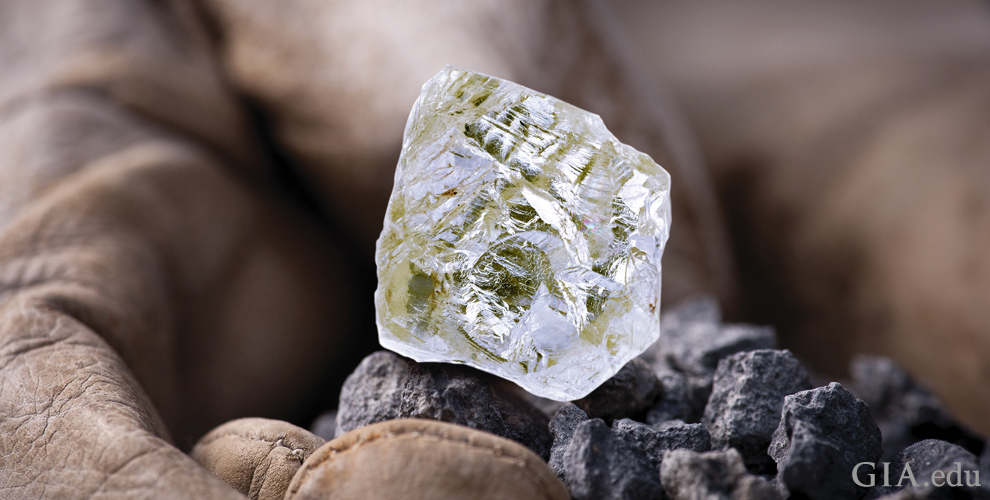Some consumers turn to Canadian diamonds in their quest for sustainable natural diamonds. Learn about their discovery, how diamonds help Canadian communities and how a GIA Diamond Origin Report lets you know if your diamond is a Canadian diamond.
In this blog, we’ll cover:
How Were Canadian Diamonds Discovered?
The Canadian Diamond Rush
Canadian Diamonds Do Good
How Do You Know If Your Diamond is a Canadian Diamond?
The discovery and mining of Canadian diamonds tell the story of the human spirit overcoming nearly insurmountable odds. The Northwest Territories, where most of these diamonds are found, have a subarctic to polar climate. It can be a challenge to survive in the ice and snow of northern Canada, let alone find diamonds.

How Were Canadian Diamonds Discovered?
Canadian exploration geologist Charles Fipke raced neck-and-neck against De Beers to help discover the first commercially-viable source of Canadian diamonds. Initially hired by Superior Oil to prospect for base metals, gold and diamonds, he ventured out independently with fellow geologist Stewart Blusson when Superior Oil abandoned the search. Through their work with Superior Oil, Fipke and Blusson knew two things setting out: De Beers was searching for Canadian diamonds in the Northwest Territories, and they were searching in the wrong place.

De Beers had found indicator minerals—minerals such as garnet, ilmenite and chromite that form in the earth’s mantle with diamonds—that suggested diamonds might be nearby. But Fipke and Blusson knew a glacier had swept these minerals over De Beers’ search area tens of thousands of years ago. Their real source could be hundreds of miles away. Fipke and his partner needed to find a vertical rock formation called a kimberlite pipe before the De Beers team. These rock formations are remnants of ancient volcanoes whose violent eruptions millennia ago transported diamonds and other minerals in magma from deep within the earth to the surface.

Fipke and Blusson continued their search for almost a decade, trekking hundreds of miles, surveying the landscape by air, and spending long hours analyzing samples in the lab when winter came. In April of 1989, a day before their helicopter funds were to run out, Fipke looked down from the sky and saw a small, frozen lake he immediately named Point Lake. Its steepness and circular shape reminded him of kimberlite pipes he’d seen in South Africa, a world away. Upon landing, he found minerals indicating that he could be on top of a diamondiferous, or diamond-bearing, pipe. Fipke and Blusson, nearly bankrupt, immediately sought the support of Australian mining conglomerate, BHP Billiton, to fund exploration of the site. Drilling beneath the lake, the company found what Fipke and Blusson had been looking for—kimberlite and, soon afterward, diamonds. The rush for Canadian diamonds had begun.
The Canadian Diamond Rush
So many miners flocked to the Canadian diamond site that BHP looped electric wires around the lake to generate a field that disrupted airborne instruments. The discovery of the Point Lake pipe was not profitable in-and-of itself. Still, it precipitated the discovery of the Ekati mine, which along with Diavik, is one of the largest of the Canadian diamond mines.

From the beginning, the Canadian government was careful to ensure that mining for diamonds would benefit indigenous peoples while minimally impacting the environment. Before mining began, the Ekati project was reviewed by the federal Department of Indian and Northern Affairs, the Government of the Northwest Territories and four indigenous groups. Mining companies had to agree to restore the habitat to its original state after the lifespan of the mine expires.

Exploration and development of the Ekati diamond mining project started in the early 1980s. Construction of the mine began in 1997 and it officially opened in October 1998. The Diavik mine, located 30 km away from Ekati, was discovered in the 1990s and began operating in 2003. Diavik will close soon, and its owners are committed to a “full and safe closure.” All ore, runways and building materials are to be removed and the fish habitat protected or recreated at the close of the mine. A sign in front of the mine states: “For centuries, people of the North have used the resources wisely…Diavik is continuing that tradition.”


Canadian Diamonds Do Good
Due to Canada’s strict environmental and fair labor laws, especially with respect to indigenous peoples, Canadian diamonds have become increasingly popular among consumers looking for sustainable natural diamonds. These diamonds are produced in an environmentally-responsible way that ensures those who helped mine and process them are equitably compensated.

Diamonds have had a positive impact on local communities and the Canadian economy. In 2003, the Tlicho Tribe, also known as the Dogribs, signed the Tlicho Agreement with the Canadian government, ensuring the Tlicho people receive 2% of the royalties from the Diavik and Ekati mines as well as royalties from any new mines in the designated area. The agreement included US$115 million (Can$152m) in cash over 15 years, plus training funds. Tlicho-owned companies also receive preference when contracts are awarded.

As of 2022, the Ekati mine employed 1,141 people, with 30% being residents of the Northwest Territories and the majority of those being indigenous peoples. The operation continues to create ancillary job opportunities in the Northwest Territories, as it employs workers to bring in supplies by land or boat, build roads and more. In addition, Yellowknife, the Northwest Territory’s capital, has a diamond cutting and polishing center.

Overall, Canadian diamonds are a vital export that boosts Canada’s economy. In 2022, Canada was the world’s third largest producer of diamonds by volume and fourth largest producer by value. Canadian diamond production is currently valued at almost US$1.9 billion annually.
How Do You Know If Your Diamond is a Canadian Diamond?
Knowing a diamond’s 4Cs (Color, Clarity, Cut and Carat Weight) is vital to appreciating its quality and value, but knowing the diamond’s country of origin is just as important. It helps us understand the impact our purchase has on the lives of the people who made these diamonds possible. Canadian diamonds are among the few diamonds that are marketed by origin, and most are traceable from mine to market. Many are inscribed with a maple leaf, polar bear or other Canadian symbol or logo, along with a grading report number, making them clearly identifiable for generations to come.

Secure ways of knowing if your diamond is from Canada include getting a diamond with a GIA Diamond Origin Report or a diamond with the GIA Source Verification Service. The GIA Diamond Origin Report provides a full and unbiased 4Cs assessment and clearly states a natural diamond’s country of origin. The report is available for select Canadian diamonds, as well as certain diamonds from Botswana, Lesotho, Namibia and South Africa.
GIA also offers the GIA Source Verification Service, which is an optional service that verifies the country where a natural diamond was mined and laboratory-grown diamond produced by leveraging third-party verified documents, including Kimberley Process certificates and invoices provided by those in the supply chain. Both the Diamond Origin Report and the Source Verification Service empower consumers to make informed choices.








